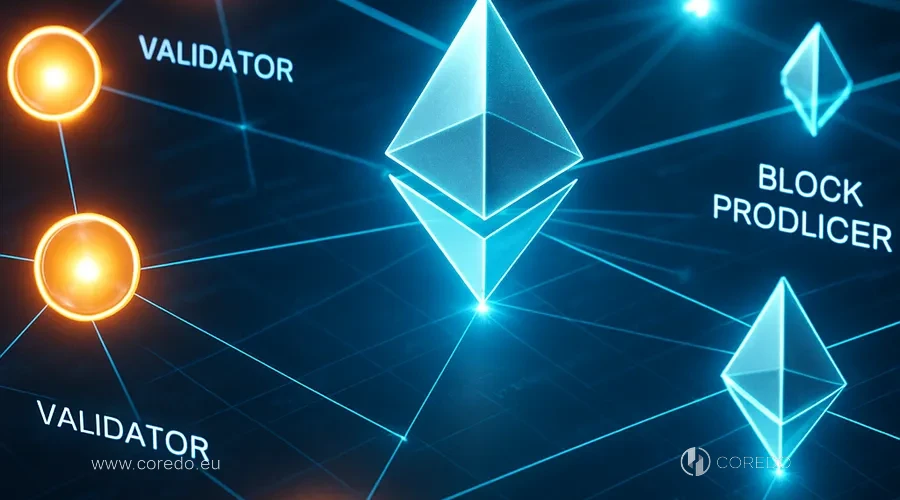In 2024, more than 80% of institutional investors consider the level of decentralization one of the main criteria when choosing a blockchain for corporate operations and the registration of legal entities in the EU, Asia and the CIS.
As COREDO’s practice shows COREDO, even large international holdings face unexpected lockouts, transaction delays and regulatory challenges due to underestimating the architectural and governance features of the Bitcoin and Ethereum networks.
Level of decentralization of cryptocurrencies

In COREDO’s corporate consulting we always start with a clear separation of concepts: decentralization of the network builders (miners, validators, block producers) and decentralization of clients (wallets, addresses, dapps). This approach allows us to account not only for the technical architecture but also for real business risks related to concentration of power or vulnerability to regulatory attacks.
- Distribution of miners and validators (structure, geography, concentration of pools)
- Number and geography of nodes
- Decentralization of network clients: number of unique and active addresses, wallet distribution, liquidity on DEX and CEX
- Resistance to forks, bugs, influence of the community and institutional investors
Decentralization of miners and validators – risks
In Bitcoin the decentralization of miners is traditionally considered exemplary. However, in practice more than 60% of the hashrate is controlled by the five largest pools, and the geographic concentration of mining in certain countries creates risks for international companies. The COREDO team has encountered cases where sudden regulatory changes or outages in specific regions led to delays and fee increases.
In Ethereum, after the transition to Proof-of-Stake, validator decentralization became dependent not only on the number of participants but also on the architecture of validator pools, the role of block producers and relayers. Concentration of staking on large platforms (for example, Lido, Coinbase) can create new points of vulnerability for corporate clients. It is important to consider that for businesses it becomes no less significant to analyze the distribution of validators by jurisdiction and their dependence on cloud infrastructures.
These parameters affect the resilience of financial operations, the ability to scale and protection from external impacts.
Proof-of-Work and Proof-of-Stake: what should businesses choose

The choice between Proof-of-Work (PoW) and Proof-of-Stake (PoS) is not only a technical but also a strategic question for companies operating in international jurisdictions. In COREDO’s practice we analyze both approaches in terms of entry costs, resistance to attacks, centralization risks and long-term consequences for the business.
PoW (Bitcoin):
- High level of security and resilience, proven over time
- Entry costs (equipment, electricity) limit participation, which leads to concentration of hashrate in large pools
- Geographic concentration of mining increases regulatory risks
PoS (Ethereum):
- Lower entry threshold for validators, which theoretically increases decentralization
- Concentration of staking on large platforms and cloud services can reduce real decentralization
- New risks related to MEV-Boost, relayers and block finalization
In light of these characteristics of the PoW and PoS approaches, it is relevant to consider the architecture and resilience of leading blockchains such as Bitcoin and Ethereum from the perspective of corporate users.
Bitcoin and Ethereum blockchains – architecture and resilience
Node architecture is a key factor for assessing resilience and decentralization. In Bitcoin the number of public nodes consistently exceeds 15,000, with a significant portion of them operating through TOR or distributed across independent ASNS, which increases resistance to censorship and attacks.
In Ethereum the number of active nodes is comparable. On the other hand, more than 60% of them are hosted on cloud services (AWS, Google Cloud), which creates new r
Risks of infrastructure centralization. In one of COREDO’s cases for an EU client we discovered that the failure of a major cloud provider could lead to reduced availability of the Ethereum network for corporate applications.
TOR nodes and geographic diversification of nodes in Bitcoin provide additional resilience, whereas in Ethereum the architecture depends on the distribution of validators and block producers, as well as integration with cloud solutions. For companies focused on international markets, it is important to consider not only the number but also the independence and geography of nodes.
Validators, block producers and relayers in Ethereum

After the transition to PoS, Ethereum became one of the most innovative platforms in terms of distributed governance. Validators, block producers, relayers and searchers form a complex ecosystem where each element affects the level of decentralization and strategic risks for businesses.
The introduction of MEV-Boost increased transparency and competition among block producers, yet it also created new centralization points: large relayers can influence transaction ordering and, consequently, business operations. In COREDO practice we recommend that corporate clients take these risks into account when designing financial services based on Ethereum.
Block finalization and resilience to MEV attacks become important metrics when choosing a platform for legal entity registration and conducting financial operations.
Wallets and active addresses on the network
Client decentralization is not only a technical indicator but also a strategic factor for liquidity, security and operational resilience. In Bitcoin, the number of unique addresses is steadily growing, indicating a broad user base and high liquidity of OTC platforms and CEXs.
Ethereum has seen explosive growth in active and unique addresses, especially after the introduction of DeFi protocols and NFT marketplaces. In one of COREDO’s projects for a client in Asia, we used metrics on the growth of unique addresses and wallet activity to assess the liquidity and security of the implemented DeFi solution.
Wallet decentralization and the distribution of active addresses directly affect the network’s resistance to attacks, scalability potential and availability of business operations. For corporate clients it is important to choose solutions with a high degree of client distribution, which reduces the risk of manipulation and increases trust in the infrastructure.
DeFi on Ethereum and Bitcoin Lightning for business

Ethereum has become the leader by number of dapps, DeFi protocols (Aave, Uniswap), NFT marketplaces (Blur, OpenSea) and integration of L2 solutions (Arbitrum, Optimism, ZK-rollups). This opens unique opportunities for scaling business processes, tokenizing assets, implementing multichain ecosystems and optimizing liquidity.
In COREDO projects for clients from the EU and Asia, we integrated L2 solutions and multichain bridges to increase performance and security of corporate services based on Ethereum. Optimistic and ZK rollups, the Superchain family and EVM compatibility allow companies to quickly scale operations, reduce costs and increase resilience to network congestion.
The Lightning Network in Bitcoin provides fast and cheap payments, while the DeFi and dapps ecosystem there is significantly less developed. For companies focused on innovation and scaling, Ethereum and its multichain solutions offer greater strategic advantages.
ERC-20, NFT, Ethereum exchanges for business
The implementation of ERC-20 tokens, NFTs and DePIN services on Ethereum enables companies from the EU and Asia to create new products, optimize business processes and attract institutional investment. In COREDO cases for corporate clients we implemented projects for asset tokenization, launching corporate NFT marketplaces and integrating DeFi protocols for liquidity management.
Comparing DEX and CEX liquidity shows that for large trades and OTC operations Bitcoin maintains leadership thanks to its high capitalization and resilience. At the same time Ethereum is rapidly catching up due to the development of multichain ecosystems and the growth in active addresses. For companies it is important to consider not only volumes but also resistance to manipulation, transparency and infrastructure accessibility.
DePIN services and multichain solutions allow integration of corporate processes with various blockchains, increasing flexibility and reducing the risk of dependence on a single platform.
Risks and trust in blockchain for business

The blockchain trilemma — the balance between security, scalability and decentralization — remains a key challenge for corporate clients. Bugs (for example, the 2010 incident in Bitcoin or the DAO fork in Ethereum), forks and community specifics directly affect trust and strategic risks.
In COREDO practice we analyze not only technical vulnerabilities but also community response, decision-making speed, and resilience to manipulation by large players and institutional investors. For businesses it is important to consider how bugs and forks can affect long-term investments, asset availability and stability of business processes.
In this context both Bitcoin and Ethereum have their strengths and weaknesses, and the choice depends on the company’s strategic goals.
Decentralization of Bitcoin and Ethereum: comparison
Comparing the level of decentralization of Bitcoin and Ethereum, the COREDO team draws a clear conclusion: neither platform has absolute superiority across all metrics. Bitcoin provides maximum resilience and reliability for hedging corporate reserves, while Ethereum offers flexibility, innovation and scaling opportunities through DeFi, NFTs and multichain ecosystems.
The economic role of ETH and BTC…The role for business is different: BTC: a hedging instrument and a long-term store of value, ETH – a collateral asset and the basis for innovative corporate solutions. The strategic implications of choosing a blockchain depend on a company’s goals: for integrating DeFi, tokenization and scaling business processes Ethereum is optimal, for custody and OTC operations – Bitcoin.
This approach allows our clients to minimize strategic risks, leverage the advantages of both ecosystems and build a sustainable international business based on the most advanced and secure blockchain solutions.